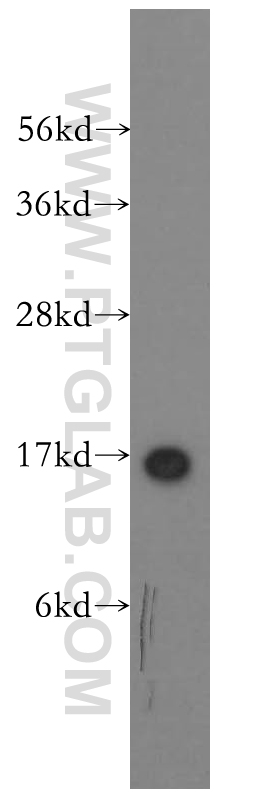验证数据展示
经过测试的应用
| Positive WB detected in | mouse thymus tissue, Jurkat cells |
推荐稀释比
| 应用 | 推荐稀释比 |
|---|---|
| Western Blot (WB) | WB : 1:500-1:3000 |
| It is recommended that this reagent should be titrated in each testing system to obtain optimal results. | |
| Sample-dependent, Check data in validation data gallery. | |
发表文章中的应用
| WB | See 1 publications below |
产品信息
11868-1-AP targets SH2D1A in WB, ELISA applications and shows reactivity with human, mouse, rat samples.
| 经测试应用 | WB, ELISA Application Description |
| 文献引用应用 | WB |
| 经测试反应性 | human, mouse, rat |
| 文献引用反应性 | human |
| 免疫原 |
CatNo: Ag2450 Product name: Recombinant human SH2D1A protein Source: e coli.-derived, PGEX-4T Tag: GST Domain: 1-128 aa of BC020732 Sequence: MDAVAVYHGKISRETGEKLLLATGLDGSYLLRDSESVPGVYCLCVLYHGYIYTYRVSQTETGSWSAETAPGVHKRYFRKIKNLISAFQKPDQGIVIPLQYPVEKKSSARSTQGTTGIREDPDVCLKAP 种属同源性预测 |
| 宿主/亚型 | Rabbit / IgG |
| 抗体类别 | Polyclonal |
| 产品类型 | Antibody |
| 全称 | SH2 domain protein 1A |
| 别名 | DSHP, Duncan disease SH2 protein, EBVS, IMD5, LYP, MTCP1, SAP, SH2 domain protein 1A, SH2D1A, SLAM associated protein, XLP, XLPD |
| 计算分子量 | 128 aa, 14 kDa |
| 观测分子量 | 16 kDa |
| GenBank蛋白编号 | BC020732 |
| 基因名称 | SH2D1A |
| Gene ID (NCBI) | 4068 |
| RRID | AB_2239283 |
| 偶联类型 | Unconjugated |
| 形式 | Liquid |
| 纯化方式 | Antigen affinity purification |
| UNIPROT ID | O60880 |
| 储存缓冲液 | PBS with 0.02% sodium azide and 50% glycerol, pH 7.3. |
| 储存条件 | Store at -20°C. Stable for one year after shipment. Aliquoting is unnecessary for -20oC storage. |
背景介绍
SH2D1A, also named as DSHP and SAP, is an inhibitor of the SLAM self-association. It acts by blocking recruitment of the SH2-domain-containing signal-transduction molecule SHP-2 to a docking site in the SLAM cytoplasmic region. SH2D1A mediates interaction between FYN and SLAMF1. Defects in SH2D1A are a cause of lymphoproliferative syndrome X-linked type 1 (XLP1).
实验方案
| Product Specific Protocols | |
|---|---|
| WB protocol for SH2D1A antibody 11868-1-AP | Download protocol |
| Standard Protocols | |
|---|---|
| Click here to view our Standard Protocols |


